#but d20 its a lot easier
Explore tagged Tumblr posts
Text
im watching fantasy high and im mildly scared that brennan lee mulligan is gonna wreck me emotionally by the end of this
#crunchyposts#but i gotta say i like cr but i like the way dimension 20 is formatted so far#cr is structured for the livestream format and its not really my thing but i really like the story#the formats just been holding me back since its hard to keep my attention with that#but d20 its a lot easier#just personally#the long form campaigns of cr and the shorter ones of d20 make it a lot harder to compare storywise so#d20#fh
4 notes
·
View notes
Text
Tactical Combat, Violence Dice and Missing Your Attacks in Gubat Banwa

In this post I talk about game feel and decision points when it comes to the "To-Hit Roll" and the "Damage Roll" in relation to Gubat Banwa's design, the Violence Die.
Let's lay down some groundwork: this post assumes that the reader is familiar and has played with the D&D style of wargame combat common nowadays in TTRPGs, brought about no doubt by the market dominance of a game like D&D. It situates its arguments within that context, because much of new-school design makes these things mostly non-problems. (See: the paradigmatic shift required to play a Powered by the Apocalypse game, that completely changes how combat mechanics are interpreted).
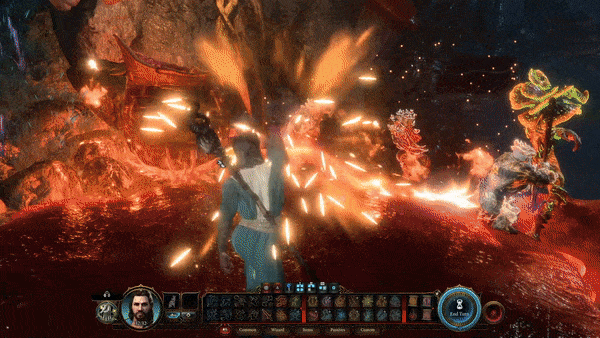
With that done, let's specify even more: D&D 5e and 4e are the forerunners of this kind of game--the tactical grid game that prefers a battlemat. 5e's absolute dominance means that there's a 90% chance that you have played the kind of combat I'll be referring to in this post. The one where you roll a d20, add the relevant modifiers, and try to roll equal to or higher than a Target Number to actually hit. Then when you do hit, you roll dice to deal damage. This has been the way of things since OD&D, and has been a staple of many TTRPG combat systems. It's easy to grasp, and has behemoth cultural momentum. Each 1 on a d20 is a 5% chance, so you can essentially do a d100 with smaller increments and thus easier math (smaller numbers are easier to math than larger numbers, generally).
This is how LANCER works, this is how ICON works, this is how SHADOW OF THE DEMON LORD works, this is how TRESPASSER works, this is how WYRDWOOD WAND works, this is how VALIANT QUEST works, etc. etc. It's a tried and true formula, every D&D player has a d20, it's emblematic of the hobby.
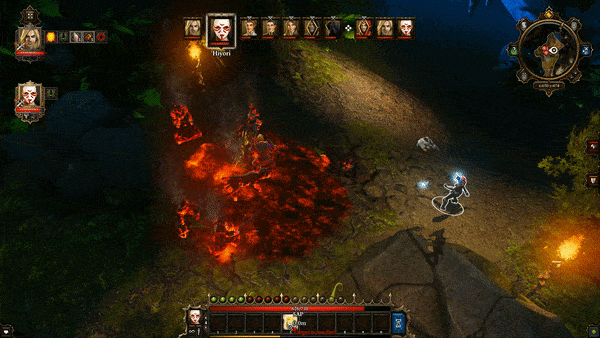
There's been a lot more critical discussion lately on D&D's conventions, especially due to the OGL. Many past D&D only people are branching out of the bubble and into the rest of the TTRPG hobby. It's not a new phenomenon--it's happened before. Back in the 2010s, when Apocalypse World came out while D&D was in its 4th Edition, grappling with Pathfinder. Grappling with its stringent GSL License (funny how circular this all is).
Anyway, all of that is just to put in the groundwork. My problem with D&D Violence (particularly, of the 3e, 4e, and 5e version) is that it's a violence that arises from "default fantasy". Default Fantasy is what comes to mind when you say fantasy: dragons, kings, medieval castles, knights, goblins, trolls. It's that fantasy cultivated by people who's played D&D and thus informs D&D. There is much to be said about the majority of this being an American Samsaric Cycle, and it being tied to the greater commodification agenda of Capitalism, but we won't go into that right now. Anyway, D&D Violence is boring. It thinks of fights in HITS and MISSES and DAMAGE PER SECOND.
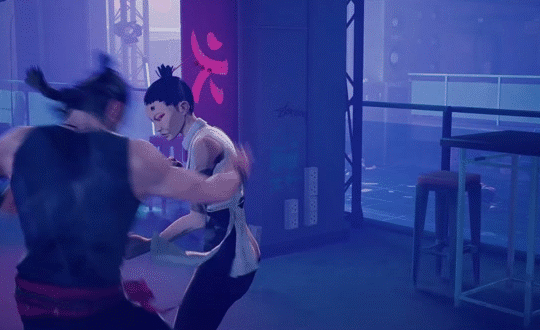
A Difference Of Paradigm and Philosophies
I believe this is because it stems from D&D still having one foot in the "grungy dungeon crawler" genre it wants to be and the "combat encounter balance MMO" it also wants to be. What ends up happening is that players play it like an immersive sim, finding ways to "cheese" encounters with spells, instead of interacting with the game as the fiction intended. This is exemplified in something like Baldur's Gate 3 for example: a lot of the strats that people love about it includes cheesing, shooting things before they have the chance to react, instead of doing an in-fiction brawl or fight to the death. It's a pragmatist way of approaching the game, and the mechanics of the game kind of reinforce it. People enjoy that approach, so that's good. I don't. Wuxia and Asian Martial Dramas aren't like that, for the most part.
It must be said that this is my paradigm: that the rules and mechanics of the game is what makes the fiction (that shared collective imagination that binds us, penetrates us) arise. A fiction that arises from a set of mechanics is dependent on those mechanics. There is no fiction that arises independently. This is why I commonly say that the mechanics are the narrative. Even if you try to play a game that completely ignores the rules--as is the case in many OSR games where rules elide--your fiction is still arising from shared cultural tropes, shared ideas, shared interests and consumed media.
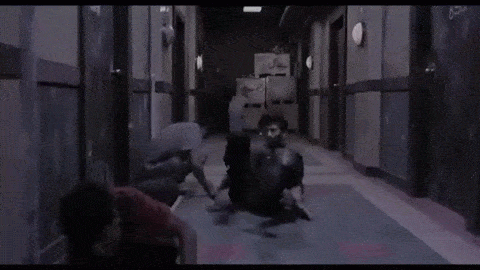
So for Gubat Banwa, the philosophy was this: when you spend a resource, something happens. This changes the entire battle state--thus changing the mechanics, thus changing the fiction. In a tactical game, very often, the mechanics are the fiction, barring the moments that you or your Umalagad (or both of you!) have honed creativity enough to take advantage of the fiction without mechanical crutches (ie., trying to justify that cold soup on the table can douse the flames on your Kadungganan if he runs across the table).
The other philosophy was this: we're designing fights that feel like kinetic high flying exchanges between fabled heroes and dirty fighters. In these genres, in these fictions, there was no "he attacked thrice, and one of these attacks missed". Every attack was a move forward.
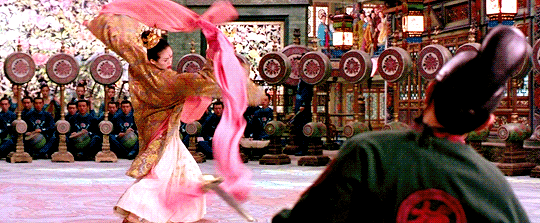
So Gubat Banwa removed itself from the To-Hit/Damage roll dichotomy. It sought to put itself outside of that paradigm, use game conventions and cultural rituals that exist outside of the current West-dominated space. For combat, I looked to Japanese RPGs for mechanical inspiration: in FINAL FANTASY TACTICS and TACTICS OGRE, missing was rare, and when you did miss it was because you didn't take advantage of your battlefield positioning or was using a kind of weapon that didn't work well against the target's armor. It existed as a fail state to encourage positioning and movement. In wuxia and silat films, fighters are constantly running across the environment and battlefield, trying to find good positioning so that they're not overwhelmed or so that they could have a hand up against the target.

The Violence Die: the Visceral Attacking Roll
Gubat Banwa has THE VIOLENCE DIE: this is the initial die or dice that you roll as part of a specific offensive technique.

In the above example, the Inflict Violence that belongs to the HEAVENSPEAR Discipline, the d8 is the Violence Die. When you roll this die, it can be modified by effects that affect the Violence Die specifically. This becomes an accuracy effect: the more accurate your attack, the more damage you deal against your target's Posture. Mas asintado, mas mapinsala.

You compare your Violence Die roll to your target's EVADE [EVD]. If you rolled equal to or lower than the target's EVD, they avoid that attack completely. There: we keep the tacticality of having to make sure your attack doesn't miss, but also EVD values are very low: often they're just 1, or 2. 4 is very often the highest it can go, and that's with significant investment.
If you rolled higher than that? Then you ignore EVD completely. If you rolled a 3 and the target's EVD was 2, then you deal 3 DMG + relevant modifiers to the DMG. When I wrote this, I had no conception of "removing the To-Hit Roll" or "Just rolling Damage Dice". To me this was the ATTACK, and all attacks wore down your target's capacity to defend themselves until they're completely open to a significant wound. In most fights, a single wound is more than enough to spell certain doom and put you out of the fight, which is the most important distinction here.
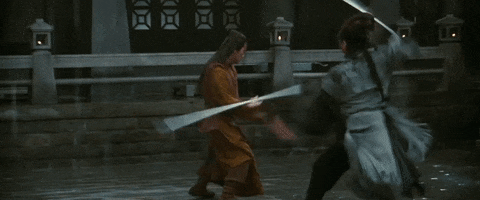
In the Thundering Spear example, that targets PARRY [PAR], representing it being blocked by physical means of acuity and quickness. Any damage brought about by the attack is directly reduced by the target's PAR. A means for the target to stay in the fight, actively defending.
But if the attack isn't outright EVADED, then they still suffer its effects. So the target of a Thundering Spear might have reduced the damage of an attack to just 1 (1 is minimum damage), they would still be thrown up to 3 tiles away. It matches that sort of, anime combat thing: they strike Goku, but Goku is still flung back. The game keeps going, the fight keeps going.
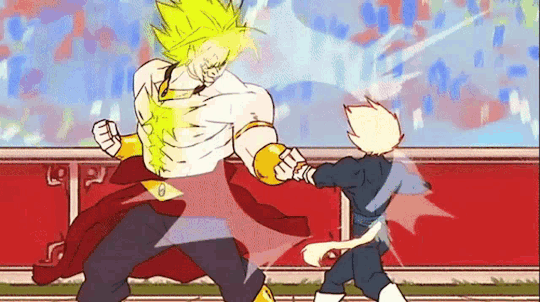
On Mechanical Weight
When you miss, the mechanical complexity immediately stops--if you miss, you don't do anything else. Move on. To the next Beat, the next Riff, the next Resound, think about where you could go to better your chances next time.
Otherwise, the attack's other parts are a lot more mechanically involved. If you don't miss: roll add your Attacking Prowess, add extra dice from buffs, roll an extra amount of dice representing battlefield positioning or perhaps other attacks you make, apply the effects of your attack, the statuses connected to your attack. It keeps going, and missing is rare, especially once you've learned the systematic intricacies of Gubat Banwa's THUNDERING TACTICS BATTLE SYSTEM.
So there was a lot of setup in the beginning of this post just to sort of contextualize what I was trying to say here. Gubat Banwa inherently arises from those traditions--as a 4e fan, I would be remiss to ignore that. However, the conclusion I wanted to come up to here is the fact that Gubat Banwa tries to step outside of the many conventions of that design due to that design inherently servicing the deliverance of a specific kind of combat fiction, one that isn't 100% conducive to the constantly exchanging attacks that Gubat Banwa tries to make arise in the imagination.
#gubat banwa#ttrpg#filipino#fantasy#gamedev#writing#rpg#dnd#southeast asia#d&d#d&d 5e#d&d 4e#i will say#that part of the decision away from a d20 (because gb alpha used one)#is sheer hater energy on my part#like i just didn't want to#because its used by all these other games by white people and especially because its used by dnd#there is like#4 instances where you use d20s in this game
227 notes
·
View notes
Note
You put a lot small visual elements and details in that I never seem to notice on my first read, and it always makes rereading exciting. What’s a detail from the comic that nobody ever seemed to notice? I’m sure there are things that nobody has mentioned, especially from the early chapters, that you’d want to talk about
Oh man.........that's a great question.
The thing is, there are a lot of details that people don't pick up, but there are definitely eagle-eyed readers that also do! There are also details which most didn't pick up until someone posted about it, and now everyone knows!
There are also details which are actually... yet to be revealed as relevant! That's a secret tool that'll help us later. :)
But most of it is plot relevant decisions I make which make the story more full, but are not necessarily NECESSARY for full enjoyment.
For example, in the very first comic, when Earl approaches Steven....

Her eye isn't white! That was a fully deliberate decision. She didn't actually approach Steven because he wanted her to. That was a decision she made on her own!
Most of the white eye shenanigans in Season 1 were deliberate, albeit not very explicit. I suppose that worked out okay, though. Plus, many people DID catch on!
Also, this part in the Kindergarten comic:
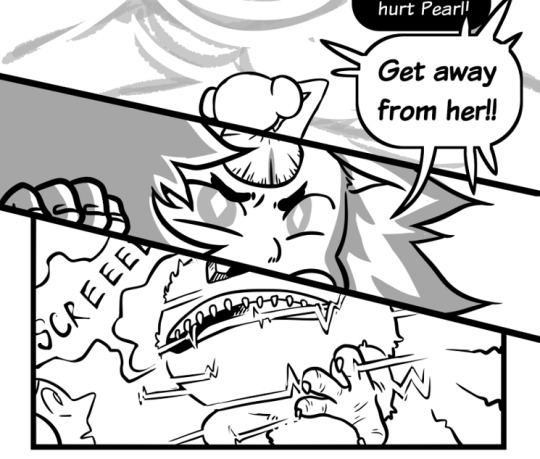
...which people assumed was a power separate from everything, is actually just the first instance of Steven's Command power. The thing is, I hadn't settled into how to portray it at the time, and also - the gem is Corrupted! It doesn't respond to Steven's commands the same way normal gems do. I planned to explore that earlier initially, but in the end, decided to tie it into much later plot.
In Season 1, EP 38, Steven asks Earl to write her name.... and she does! But in gem, not English, because she doesn't know how to write in English.
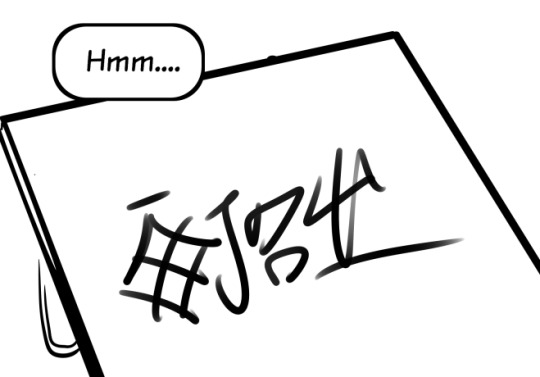
She designates herself as White Pearl, putting the dash over the top diamond. It was at the time when she was still anxious about making Steven - White Diamond - angry with her.
And to add to the eye thing - during the Season finale of Season 2, when Steven wondered if Earl only came to see him because he forced her to - the comic where she finds him in the water proves otherwise!

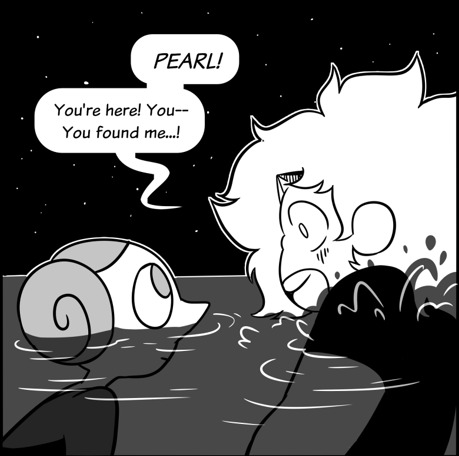
Immediately when she grabs him and swims up, her eyes aren't white! She's doing it of her own accord.
Also, in Season 3's opening, when Rose is angry at what she THINKS is White Diamond, she almost has a slip of the tongue when talking about the past.

There's a very pointed reason that panel of Earl is right there next to Rose's cut-off 'My...'
Also, when Rose leaves Steven in the Containment Sphere - the Baby Jail Bubble - she unlocks it to leave, and you can pretty clearly see an interesting detail.
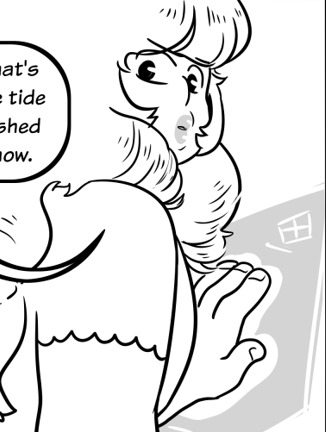
(which Steven, of course, doesn't notice.)
There's also a bit of a narrative tongue in cheek line-up which is accidental on Steven's part but still rings true:
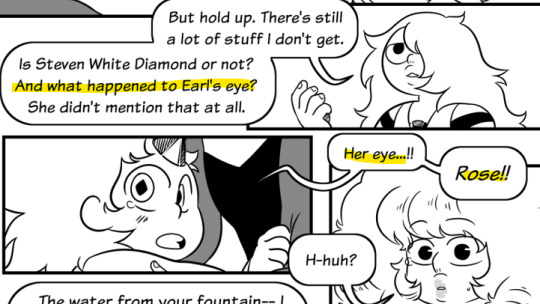
(TVTropes editors caught this one! Hey TVTrope editors!)
Also, this very famous Seaglass foreshadowing:

The first instance of Steven connecting to tech was in the beginning of this season!

When Steven has a bad dream after fusing with Earl and forming Bleached Coral, there's a hidden detail in this reflective text from Nightmare Rose:

(It might be easier to read if you mirror-flip it.)
Another fun thing I enjoyed doing before I got busy with other stuff is gem language! Earl writes Steven notes in it to help him learn, and now signs with her English name,
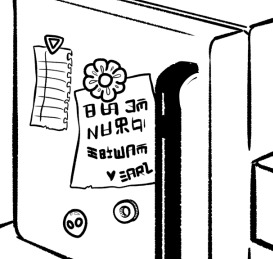
In the Cluster Experiments comic, if you look at the panels before stuff starts to Happen, you can find a few Experiments hiding in the background. :)

In Amethyst's room, there is a Japanese stopsign and a d20 in the background.
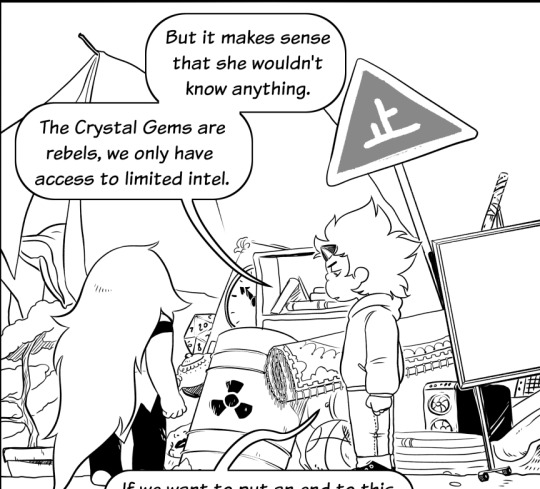
In episode 25 of season 4, Steven is playing Moonlight Sonata!
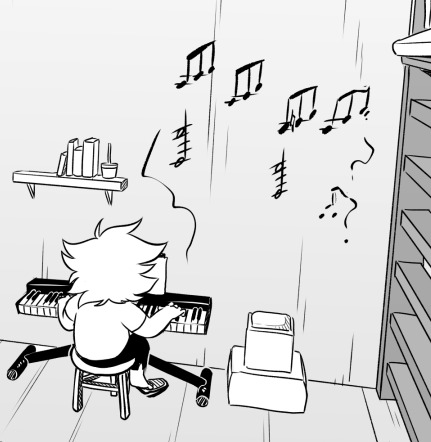
In episode 33, the ship Steven connects to displays a bisection of the earth which showcases its lumpy core! Or rather, the megastructures that are hidden deep inside the mantle.
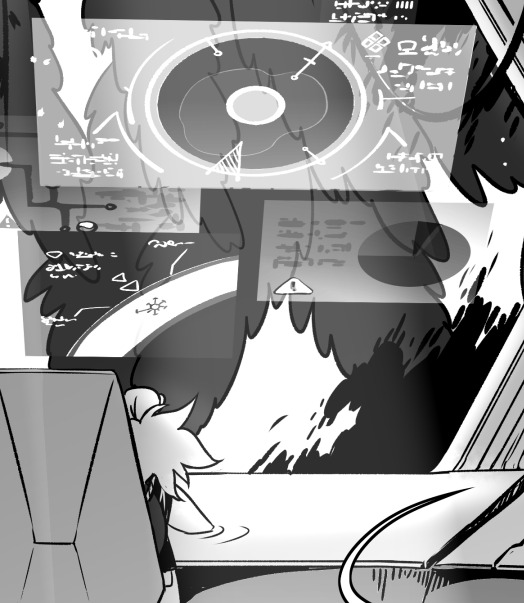
It also showcases a few geothermal coring sites made during the colonization.
And by the way, the drill Pearl built was actually a repurposed ship hull which was used for the Space Race ship in the original show!


And man there are actually... many more! But I had to skip over them because they are alluding to things which have not yet been explicitly revealed! :D
But even with this, I'm sure there are other ones I'm missing. If you think you have one that should be listed - throw it on a reblog or in the comments!
517 notes
·
View notes
Note
even though I think both sides of the mismag controversy have valid points, for me the biggest disappointment is more just that this is the second d20 sequel series this year. Like I don’t hate the idea of doing a sequel series but I feel like of all the seasons that could’ve gotten a sequel mismag is probably among the weakest pick. Hell they didn’t even have to do direct sequels, even just having a completely different/new cast but familiar setting that gets expanded would’ve been so interesting. I also find the fact that both of the sequel seasons take place in a school setting kinda boring if not straight up annoying to me personally.
Imagine how cool a mice&murder sequel season would be! I love that season and even though I think the crew and cast did phenomenal even with the restrictions, imagine how much further they could go! Or acofaf??? Probably wouldn’t be a very seasonally in theme season though since we’re entering fall. Like Idk what it is but I feel like d20 this year has kinda lost its spark with all of its seasons feeling kinda samey settings wise. It’s probably more just a lack of variety but either way it’s really bumming me out : (
that is fair, i do want to say tho, school settings are largely easier to return to because the parties stick together for more time. most of the mice & murder characters for example did not travel together or anything, their primary connection is Squire Badger.
although a fall themed acofaf season would be cool, a lot of these characters arcs are complete, 6 out of 6 pcs are in relationships, and Jane Austen kinda needs single characters. so they'd have to bring in new blood
#ask#dropout#dropout tv#dimension 20#d20#dimension twenty#acofaf#fhjy#a court of fey and flowers#dimension 20 fhjy#brennan lee mulligan#bleem#aabria iyengar#mismag 2#d20 mismag#misfits and magic#mismag#misfits and magic season 2#anti mismag#d20 misfits and magic#d20 fhjy#anti fhjy#d20 fantasy high#fantasy high#dimension 20 fantasy high junior year#mice and murder#mice & murder#anti misfits & magic chapter 2#anti misfits and magic chapter 2#anti misfits & magic season 2
42 notes
·
View notes
Text
reporting from the Dream Library: Apocalypse World
After however many years of games pointing its direction, I finally played Apocalypse Worlds as the first leg of a long series of one- and two-shots I’m running over in the Dream Library, my weekly drop-in-game-and-design-chat discord. We’re starting a unit talking through some of the highs, lows, landmarks, and cul-de-sacs in the now fourteen-year long history of PBTA design — it’s looking something like an actual play book club.
It’s an interesting journey to be embarking on — and I’ll talk a little bit more about where we’re going next at the end of this post — but, hey, first:
I fucking loved Apocalypse World.
Part 1: Big Thoughts & Caveats
Apocalypse World rules. That isn’t a particularly hot take, and it isn’t a set up for me to tear into the game later. I’m not being polite here. The game fucking rules. Every time I opened the book (I’ve got both a physical copy and a pdf of the second edition), I was confronted by some absolute sick nasty shit that slapped and fucked and went supremely hard. The game is good good good in a way that, tbh, makes me a little disappointed in a whole bunch of PBTA games that come after it and totally miss, imo, where all the cool shit in Apocalypse World came from.
There’s a way in which, speaking as a mostly casual observer who was mostly not around during the big years of the PBTA boom (for those keeping score at home, I listened to Friends at the Table on and off from about 2016 on and played a handful of Dungeon World and Sprawl sessions as a result, but didn’t start actively participating in the blood machine we call design discourse until after I graduated college in 2021), what seems to get fossilized as the core of PBTA design, especially in the public pitch for various systems, is mostly the simplicity of the dice and resolution systems — make a move, roll 2d6+stat, partial successes, isn’t this so much easier than d20 rollover?
And, sure, those form a part of the marketability of PBTA, especially to a mainline RPG audience. But there’s more than just that in this book — a lot more — in a way which makes me upset that this wasn’t the shit I was hearing about at 17. Meguey & Vincent Baker have skill for designing with what you might call elegant maximalism in mind, a philosophy where you are constantly confronted — especially when handling the physical object — by a book which is impressive both in its length and in its density.
Apocalypse World (like Under Hollow Hills, which we’ll be playing at the very end of our PBTA unit in the Dream Library) is remarkable both for the number of moving pieces and for the fluidity with which those pieces fit together. I understand why that kind of game, coupled with how easy it is to hack moves into something entirely new, leads to a design moment which emphasizes rules-light play, but — agh! There’s just so much more game in Apocalypse World than in so many of the games which build on it. The text calls for the MC to “barf forth apocalyptica” — and it feels like Vincent and Meguey have done something similar, here, cramming everything which makes the game interesting right into the text.
All that being said, I butchered this game in order to run it as a one-shot. Apocalypse World should not be run as a one-shot. There are lots of very funny forum conversations to be found, if you start looking online for advice on running Apocalypse World as a one-shot, where people tell each other not to run Apocalypse World as a one-shot. In several of them, especially on the old lumpley forums, Vincent chimes in and suggest not running it as a one-shot.
Unfortunately, the limits of trying to run a series of games in conversation with each other, in a reasonable period of time, with a rotating set of players means that I can’t play Apocalypse World the way you’re supposed to. I’m going to host it again later this month, and I may try to run that session as a a little more of an as-written Session 0 (or follow Vince’s advice on playing it con-style to the letter), but that’s getting a little close to what-comes-next talk, which I said I’d save for the end.
All-in-all, I’m not terribly unhappy with the way my cobbled together one-shot went, but — as I talk through some of the points of friction in a moment — I’m going to try to keep in mind (and I’d like y’all to keep in mind too) that much of this is my fault, for breaking the game before we every played.
That being said...
Part 2: The Session
I had four players, who made characters ahead of time — except for Hx, which we did at the top of the session. None of them, as far as I know, had played Apocalypse World before. We got an angel, a battlebabe, a brainer, a hardholder out of it.
There were strengths and weaknesses to prepping characters ahead — while it did save time and let us play harder and faster than we would have otherwise, I struggled at times with what felt like an almost immediate divide between player characters: the hardholder and the brainer on one side, the angel and battlebabe on the other. There wasn’t player tension or conflict — just folks interests going in different directions, which is 1. totally fine, and in fact can be fun to play with over a longer time and 2. probably my fault for giving players the full list of playbooks. Hardholder is good shit, but it’s also big and requires more prep than basically any of the others, and then grounds you in a world I wish we’d had time to explore longer.
I prepped a holding, with the help of our hardholder Mother Superior: the Red Priory, an underground market in the tunnels beneath the ruins of a city-which-was, located on the remains of an interstate highway in the slow process of sinking into the burned and blackened mudflats left behind when the wetlands dried up. I prepped some threats: a gas supplier to the west and a gang called the Crow-Eaters who were picking off caravans to the east. And then we jumped into play, opening in media res. Mother Superior was stranded, hunted by the Crow-Eaters as he tried to make it back to the safety of the Priory, while our other players (Charmer the Brainer, Kerrbox the Angel, and Rapture the Battlebabe) set out looking for their boss. Again, a breach of how the game is supposed to run, but opening with something high-octane felt important when we only had a couple of hours to dick around in the world.
We had a brief encounter at a blockaded highway, some good chats about the safety and feasibility of offroading on a dried up swamp (don’t), and an absolutely miserable (in a good way) knock-down, drag-out shootout between Mother Superior and his pursuers, which ended when an escaping Crow-Eater rode headfirst into our other players’ search party and wound up getting dragged behind a bike some five hundred feet down the road, psychically interrogated, and imprisoned in the Red Priory. Having made it safe — but badly injured — back to the holding, we capped off the session — and our story — with an attack by the full Crow-Eater gang riding a souped up bulldozer and a fleet of bikes which Kerrbox and Rapture road out to deal with while Mother Superior drifted semi-conscious in a hospital bed, dreaming with Charmer about the Crow-Eater’s boss, Lady Magpie — who, at that moment, was dueling Rapture guitar-ax-on-chains on top of the bulldozer. Every step in the process was sick as shit. The combat felt great, the social dynamics felt great, the shifting scales of threat and tension as things amped up felt great — and even with a couple of players with pretty limited RPG experience, the game felt like it had an interesting answer (or a way to find an interesting answer) to every question we hit. As always when playing online, I did wish we were in person (flipping through a book around a table just feels better than flipping through a book on a discord call) and we ran into the usual hiccups with to do the move, do it type games: cases where players had an interesting image of what they wanted to try which the moves didn’t quite cover and cases where players knew what move they were angling for but I had to push them to frame it narratively — but both of those things are solved by familiarity, and would have been smoothed out if we’d gotten to play for longer.
There’s a slightly paradoxical way in which a one-shot of a GM’d game tends to rely more heavily on the GM than long term play does, especially when the non-GM players haven’t spent a lot of time with the game beforehand. Even if you aren’t expected to have prepped as thoroughly as you might for a campaign, the labor of hosting and facilitating has a tendency to balloon in a first session, and there were a number of times when my players looked to me for answers when, in a longer game, I’d like to think they would have felt comfortable answering the questions themselves. Some of this is just players getting warmed up to the space and to playing with each other, but there’s another edge as well: I think some players have a tricky time feeling like they can claim authorial power in a one-shot. A one-shot is perceived as a kind of bespoke experience, something hosted by me for you — a perception which, I admit, I play into when I end a Dream Library session by thanking my players for joining me. I don’t know why I do that — I certainly don’t feel that need when I GM an ongoing campaign — but I do.
Apocalypse World is a great game for breaking this habit. Even as I over-prepped for the first session, limiting myself to developing threats (and the basic setting details worked out with the hardholder) meant there were moments when not only did my players ask me questions I didn’t have an answer to, but questions which I did not feel I was the right person to answer at all, and I passed authorship off — either back to them or to another player. Breaking up the authorial duties by making it extremely clear what the MC is and is not is a huge part of what makes the Bakers work tick — and something I’ve seen them do in other, even more asymmetrical games (like the excellent Wizards Grimoire zines which are on sale right now).
On top of that, though, Apocalypse World gives you Agendas, and most importantly the command to “Barf forth apocalyptica” which I mentioned once already. In a one-shot, having a textual instruction to answer questions with the most grotesque, evocative, and apocalyptic answer we could find was an incredible mandate which changed the world in the process of play. The mudflats got muddier as we went, the Red Priory seedier. By the time we met her, Lady Magpie had discarded her original fit for a massive cloak strung with bits of broken metal and glass which clattered and flickered with her every movement.
Apocalypse World enshrines the call to lean into the obvious answer into its text, reminding us that it is, in fact, fun to play in genre. It is fun to play in the trope. It is fun to make things strange and beautiful and frightening purely for the purpose of being strange and beautiful and frightening. It fucking rules.
I wish, again, that I’d gotten to play it longer, and watched the world get even weirder and more apocalyptic.
Part 3: What Comes Next
I’ve got another session of Apocalypse World that I’ll be recruiting for in the Dream Library basically as soon as this post goes up — then next month we’re moving on to Night Witches and Sagas of the Icelanders to talk a little about historical fiction and genre. The schedule beyond that has been laid out, but only tentatively (at one stage, I had games planned to run until next April, which is absurd, but I’m trying to keep things flexible and let the unit lead us where it does). If you’d like to get in on the action, shoot me a message! I’m not posting the link to the Dream Library anywhere publicly at the moment, but genuinely — if you want in, you should come on in. If you don’t want to play, you don’t have to play — we’ve got a little text-based book club talking through the games simultaneously to our unit, for folks who can’t make it but still want to talk games.
On the other hand, if you want to run a game you should for sure let me know. I’ve already got a few guest hosts lined up, and I can’t wait to see what they do. Is there a game you think is secretly the key to understanding PBTA? Something you’ve been itching to try, but never found a group for? A game you hate, but feel obligated to talk about anyway?
Come and join. We’d love to have you.
We’ve got fourteen years of design to talk shit about, after all.
#ttrpgs#ttrpg design#indie ttrpg#apocalypse world#pbta#powered by the apocalypse#dream library#play report
49 notes
·
View notes
Text
Let's Talk About: A Meeting of Misfits

It's the season premiere of Misfits and Magic Season 2--and I'm recapping and reacting and being petty against those people who are hating on the show because of the franchise that must not be named!
Yeah, I'm not above being petty. Especially in service of something that's made to bring joy. So let's crack in!
Right off the bat, the new mechanics is throwing me for a loop. I think it's something we need to see in action to understand better. Which is pretty par for course in terms of tabletop role-playing games in general. I trust Aabria completely though because A Court of Fey and Flowers remains one of my favorite Dimension 20 seasons. And it's pretty unconventional when it comes to mechanics.
Starting with Lou/Whitney Jammer and having him roll consistent 1s… is making me miss the Intrepid Heroes who would've definitely grabbed his dice to throw them away. That said, I do love the Magical Misfits even though the original season didn't grab me as much as other seasons of Dimension 20. Probably because I watched it when I was already disillusioned with "the franchise."
But having said that--this episode was amazing at getting us up to speed with what's happened with the cast of characters we got to know…and, unsurprisingly, it's done a better job at establishing a sequel that fits the mythology (and characterization) of the original. Which I add because I read the accursed sequel of "the franchise" and wish I could turn time back for that to stop myself. Because it truly lived up to its title being cursed.
Moving on though, to something that's actually good:
Aabria sets up the stakes beautifully in this episode. Although some bits do go one a little longer than I would have liked, I do feel like the players were allowed to play more since there's only four of them. I get the feeling, based on Aabria's other work, that she's more cognizant of giving everyone time opportunities when the player group's bigger. Like in her other D20 episodes, or non-D20 projects.
I'm very curious as to where Erika plans to take K's storyline with, what I assume, is a devolution for her character? There's complexities in the beginning of her journey that I fully don't grasp yet…but I am excited to see where it goes.
Lou and Danielle choosing to keep their characters very familiar--while also having subtle hints at things having changed--is easier to digest for me. It may have been three years for the players, but it's only been a few months for me. (I watched the original season after Junior Year and before Never Stop Blowing Up.) And Lou and Danielle's decision to make their characters seem static is playing better with my brain. (This could also be the lack of sleep and headache talking.)
As for Brennan and Evan Kelmp… What do I say about his character choices that won't rile up the group of people who think Brennan is hogging the spotlight?
Now, I wasn't a fan of Evan Kelmp in the original season. But it wasn't so much because of Brennan's portrayal or the focus that was unavoidably given to him. Brennan made a big swing when he created a character that would help move the series along. But Misfits and Magic, the original season, only had four episodes. Of course it would feel like Evan got too much of the spotlight. There wasn't a lot to go around with. That being the case, his character was important then…
And it's important now.
Brennan's choices that made Evan who he is allows the other players to play the characters they want to explore without having to think of the plot. They can focus on the character growth they wish to get into. And… Honestly? Without the Evan-K romance? I think I'm coming around to Evan.
So overall? I think the season premiere of Misfits and Magic 2 is pretty solid. The episode had everything: we had catch ups, we had an after-school program, we didn't wave away any problems that arose from the original season…and are actually tackling them head on now, we have Britain's Got Magic while magic is actively becoming chaotic, we had Tony Danza, and we have a talking rock. With eyes and a mouth.
Because of course Aabria is going to bring in a new kind of magic to the dome. It's tradition.
So to the people who are writing the show off because they think it is celebrating "the franchise?" Joke's on you because you're the one missing out on a show that has a better plot and a better grasp on its world. And it's being improv'd on the fly.
And just to make it clear--I no longer support "the franchise" too. Because FUCK TERFS.
#dimension 20#dropout tv#misfits and magic#mismag 2#d20 spoilers#aabria iyengar#lou wilson#erika ishii#danielle radford#brennan lee mulligan
20 notes
·
View notes
Text
Thinking more about Kristen and Cassandra.
I’ve seen people say that Kristen’s continued dismissal of Cassandra (and also I might argue… discomfort? with her, or confusion how to relate to her) feels like a story let down after the end of Sophomore year, and I do agree with that. The moment Kristen finds and rescues and creates Cassandra is so so special. It’s the result of a classic Beardsley Nat 20 that Brennan spectacularly honors. It feels, in some way, like a gift between Brennan and Ally but also between D20 and its queer audience. It says “we believe that queer people have their own divinity”. It made me cry when I watched it.
So it does feel like a story let down to still have Kristen be dealing with the same chaos and confusion, to have her not learned the same thing that the audience did from that moment. It is disappointing. But also I think they’re doing that intentionally.
Pushing back against the finality of story climaxes, and examining what happens after the final battle is won, is definitely what this season is all about. It’s why we finished at the very end of the Night Yorb quest; this whole season is about what happens after, about the part that isn’t decisively solved in a huge moment of glory. It’s why Kalina is back, probably in a different role than before. The season is about the messy parts and the way you have to heal in real life- little by little.
Now, will they manage to make this kind of season as emotionally cathartic as sophomore year with it’s big final battle that solved all the problem? I have no idea. This kind of story telling is a lot harder to do. It’s more realistic, but it’s bucking a more traditional story structure that’s a lot easier to fall back on. It might work or it might not. But I do think it’s cool that they are taking these kind of risks with Fantasy High, because it’s what they needed to do to keep the series fresh and real feeling. I do think Ally has a real arc for Kristen in mind, and I’m really interested to see where they take her.
53 notes
·
View notes
Note
HAI SPENCER!!!! i started watching d20!!!!! i'm just on fantasy high (i can finally recognize ur pfp lmaoo) but do u have any other season recommendations? :O
OMG HI JUPITER !!!! fantasy high is literally so fun i love it sm. for recommendations: if youre watching on youtube, then fantasy high is the only campaign you can watch. but! if youre watching on dropout, then heres a short list of my favourite seasons (in no particular order) other than fantasy highs other seasons + short summaries (ill try not to ramble too much lmao)
a starstruck odyssey
a chaotic campaign abt a spaceship crew set in a futuristic 60s retro universe and the different jobs they do (mostly crimes, honestly.) starstruck can be a bit numbers and mechanics heavy, so it can sometimes feel like way too much information all that once, but thats usually just during the battles and the roleplay moments are usually breezier
misfits & magic
a short campaign (4 eps + a holiday special) abt a group of kids that all get sent letters from a knock-off hogwarts. brennan is actually a player in this one! the character he plays is genuinely one of my favourite d20 characters ever. misfits & magic is basically just teenagers being stupid teenagers and i love them all sm
a court of fey and flowers
fey regency!! this campaign is all abt relationships and status. chock full of drama and romance (and brennan is a player again!)
neverafter
TWISTED FAIRYTALES !!! all the characters are from classic fairytales but with a little fucked up twist. neverafter deals with a lot of heavier topics and is d20s first official horror season, but each episode has its own list of content warnings which can make it much easier to watch
the seven
a fantasy high spin-off!! it has such a vibe that i can only describe as 'highschool girl friendgroup'. none of the pcs from fantasy high show up, but a good chunk of the npcs do!
anyways thats probably a good list lmao. sorry for answering this late, i drafted it and then immediately forgot abt it 😭 hopefully you enjoy at least one of these seasons and that youre enjoying fantasy high!! happy watching!!!
8 notes
·
View notes
Text
How to Play Pokemon Without Dishing Out 60 Dollars: a Guide to Pokemon as a TTRPG
I thought this would be a fun thing to do, as I’ve been a part of three ttrpg (D&D eqsue) pokemon campaigns and both use a similar set of rules for how its done (I helped co-create this specific system for how it works to begin with). So this is going to be a long post about the mechanics of running a Pokemon D&D/ttrpg-style campaign! Since this is going to be one HELL of a long post, I’m putting it below a read more!
Alrighty, let’s get into this shit!
First and Foremost
Resources that will make your life SO MUCH easier:
https://pokemondb.net/ (Literally going to be your best friend. Use it.) https://rolladie.net/ (Or any dice-roller website (or actual dice), this is my go to because you can put custom values into it) https://bulbapedia.bulbagarden.net/wiki/Main_Page or https://www.serebii.net/index2.shtml (basically any pokemon wiki that gives you access to item info, shops, areas and maps!) A calculator of some type, weather digital of physical (you will need this, trust me)
Stats
Pokemon have... a lot of stats and it involves a lot of numbers, and the aim of this is to reduce the amount of math needed to be done as much as possible. So there are 4 stats that actually matter to us when it comes to this guide, and those stats are: Health, Defense, Special Defense and Speed You can find all of these specific stats for every pokemon on the Pokemon Database (first link under Resources)
Speed will determine the turn order during a battle, just as it does in game. This stat remains static no matter the level of the pokemon, and only can change with evolution or an fed item that can increase the base stat in game.
A pokemon’s base health stat is exactly that, it will be their base health. With each level, a pokemon gains usually 2 HP. To calculate the health of a higher level pokemon you can do the following formula:
Base Health + 2(Level)
This will give you the base health of the pokemon. This stat can change with evolution so sometimes a recalculation is required.
Defense and Special Defense only truly matter if they are HIGHER then the pokemon’s base health. If a pokemon’s base health is lower then one of its defense stats, the defense stat becomes the new base health. This is so that more tanky pokemon retain this.
Leveling Up
The leveling system is also simplified. A pokemon requires only 100 XP to level up each time, making the meter look more like this:
0/100 XP
The XP yield from battles is determined by the DM, just go ham there doesn’t exactly have to be rhyme or reason to it, if you have a plan for the levels of each area/story beat, try to manipulate the XP drops to keep your party on level.
Wild Encounters and Catching Pokemon
The Wild Encounter system for this is pretty simple, pokemon have designated areas that wild pokemon spawn in, aka the tall grass. Have your players roll a varying number of d20 (depending on how big the grass patch is) and if they roll a number that is above a 10, they are given an encounter.
Utilizing one of multiple pokemon wikis, you can find the spawn rates of pokemon within specific areas, usually the pages for the Routes contains this information! From there you can create a table of sorts, and with that table your players can roll a 1d100 to see what exactly their encounter.
To catch a pokemon, one must, of course, utilize a pokeball. When a pokeball is thrown, the pokemon must do a 1d20 saving throw against the player. If the player rolls higher then the pokemon, then the catch is a success. Modifiers do apply to catch rates.
If a pokemon’s health is very low, their roll can be subtracted from by a number the DM can determine. If it’s high, their roll can be added to. Different pokeballs have different modifiers for their catch rate, a great ball can add a +2 modifier, a ultra ball a +5, for example. The DM themselves can determine the modifiers.
A pokemon’s gender is determined upon capture, for the most part you can just flip a coin for the gender.
For fun, you can also include a shiny percentile. This can be done by rolling a 1d100. If a player rolls a nat 100 after catching a pokemon, that pokemon is shiny. (The campaigns I’ve played in usually go for 95 or above as shiny)
Battling
Alright here’s where a LOT of the math comes into play. Get out your calculator y’all. As you probably know, all damaging pokemon moves have a Power Level, and this power level will determine the hit-dice (aka the amount of dice you roll for damage) that the move has. The power level functionally becomes the highest amount of damage that the move can do.
For example, tackle is a 40 power move. This means it would utilize 2d20s as the hit dice. The number from that roll would be the damage. A 100 power move like Spacial Rend would utilize 5d20s as the hit dice, as 100 damage would be the maximum.
For the moves a pokemon can learn, utilize the Moveset from the most recent pokemon game. This can also be found on the Pokemon Database.
Accuracy is usually not calculated for unless it is an intrinsic part of the move, such a Sheer Cold of Guillotine. These moves would require the rolling of a 1d100, and if the number lands within the percent range of the attack’s hit chance, then it lands. (However, if you wish to include accuracy, use a 1d100 and if you roll below the accuracy number, then it hits). If a pokemon is attacking out of battle, and for this example we will use attacking a trainer, they must roll a 1d20 for their aim. The one they are attacking must roll a 1d20 against this attack. If the attacking pokemon rolls higher then the target, they hit and now its time to do the damage calculations. If the target rolls above their attacker, they dodge. Human character’s HP can be determined by the DM, but 100 HP is always a good number to use.
Similarly, a moves PP (Powerpoints) are also not calculated for the most part. The only exception it the signature move of a legendary, or one that specifically has a PP level of 5 due to its power.
Super Effectives and Resistances work as normal. A normal super effective hit does double damage, while a resistance takes half the damage. A quad super effective if 4xs the damage, and a quad resistance is 1/4 the damage. If you don’t feel like memorizing a typing chart, or keeping track of multiple things, resistances can be expunged and only super effectives kept if one needs additional simplification. This is all up to personal preference of the players and DM.
Mega Evolution increases the health of a pokemon by 25%, and adds a +20 to their damage output. Undergoing mega evolution requires the player trainer to have a keystone, and a corresponding mega stone for their pokemon.
If one wishes to give their trainers an extra challenge, operate on some of the Nuzlocke rules! You can add extra tension or stakes by making pokemon killable. With these rules, if a pokemon hits 0 HP, they must roll a 1d6 saving throw. If they roll above a 3 they live but are in critical condition and fainted. If they roll below that the pokemon is dead.
Example of a Pokemon’s Information + Template
An example of how a pokemon’s information can be set up is as followed:
Eclipse Female Charizard (Shiny) Fire-Flying Type Level: 45 (20/100 XP) HP: 168/168 Moves: Flame Burst (3d20, 1d10 burn (fire)), Wing Attack (3d20, (flying)), Fire Fang (3d20, 1d4 for burn (1d6 damage) (fire)), Flamethrower (4d20 + 1d10 (fire)) Ability: Blaze (Increasing fire-type moves power by 50% when below 50% health)
And here is a blank template for your own use:
[Nickname] [Species] [Typing] Level: (0/100 XP) HP: Moves: Ability:
The World Around You (NPCs, Shops, Items, the Map)
The use of NPCs (especially trainer NPCs) will really depend on what you’re doing for the campaign’s story. If it is taking place in a pre-existing region, then you can utilize any pokemon wiki to see what trainers are in specific areas, and see their team and moves! You can utilize the multitude of NPCs that exist. If you’re doing something completely original, or in a fan-region, the DM will have to set up all of the NPCs on their own. And of course, you can use this to play around with the characterization of pre-existing pokemon characters. Have fun with em!
Shops and Items are relatively straight forward. You can utilize the prices from the most recent games for items as a way to price them for purchase. (For example, pokeballs across almost all games cost 200 pokedollars) Pokedollars can be given to players are post-battle rewards, quest rewards, or just in general found items (or stolen if you want smh).
The Map, Route, and World your players explore once again heavily relies upon what your campaign is. If its within a preexisting region, you can access the map and routes from any of the pokemon wikis and work from there. If its a fan-region, then the map and routes can be custom made. And you are always free to add or take away things! You do not have to fully adhere to everything.
Story, Plot, all that Jazz
The story and plot is all up to you as a DM! Are you running a campaign that is the same as the plot of one of the pre-existing games? Are you modifying a pre-existing game to change the story? Are you throwing it all to the wind and using your own fan-region and fakemons? Are all your players characters friends about to embark on the gym challenge, only to be swept up in the dark plot of an evil team? Is it a band of guild pokemon going on an adventure Mystery Dungeon style? The sky is the limit! Have fun with it! :D You are not constrained by much of anything plot wise! You can make it a fun and silly adventure with friends in a fantastical world, or it a dark and tragic tale full of bloodshed and perseverance through world-ending catastrophe. Or like... both. Both is good too.
And that, everyone, is how you play pokemon with friends without actually buying a pokemon game! And hey, this time its multiplayer!
If you have ANY questions, hit me up and I’ll be happy to answer you!
#pokemon#pokemon roleplay#pokemon rp#pokemon d&d#d&d#dungeons and dragons#long post#ttrpg#pokemon ttrpg#dino screams asmr#THIS HAS BEEN IN MY DRAFTS FOR TWO YEARS IM GONNA SHIT MYSELF I KEEP FORGETTING TO POST IT
87 notes
·
View notes
Text
i wanna scream from the heavens "GO PLAY LOBCORP AND LIBRARY OF RUINA NOW NOW NOW" like everyone else when it goes on sale, but hear me out. What if you can only buy one. Or only want to buy one for some reason. Or maybe it's like a book and you want to know what's in the book before you buy the book. Let me help you, ok?
For ease of scrolling I'll just put the rest beneath a cut. Below is me going over everything notable about lobcorp and library of ruina that would influence the decision of what you want to buy, positive or negative. Mostly positive, though.
WHAT DO BOTH OF THEM HAVE?
Customizable side characters to get attached to. Employees and Librarians.
A story about the horrors of capitalism, I think.
A world that they expand upon to such a huuuuuuge degree. Lots of worldbuilding. Huge world.
Lots of beasts!
Both have soundtracks that will explode you!
They also have a lot of body horror and gore in them. Be safe, okay?
WHAT DOES LOBOTOMY CORPORATION HAVE?
Lobcorp is a management game. If you like to manage things, it might be for you! Basically, you work on monsters to make energy, and you need to work on them to unlock more information about them to make breaches less likely. It's a game of experimentation!
Failure is about halfway between forgiving and not. Resetting the day if something bad happens costs nothing (barring a few exceptions, but those are very, VERY rare). But you have to actually finish a day to progress. Take the knowledge of what went wrong to try and fix your mistakes! ...But sometimes that doesn't help, either... It's that kind of game.
You have to let your agents work on Abnormalities to improve their stats and let them use better equipment! It's easy to get attached to your little guys, if that's a plus.
Story's pretty good, y'know. I'll leave discussing the nitty-gritty of what Lobcorp's story is about to the professionals, though; I didn't pay enough attention to it cuz I was more focused on the gameplay.
Lobotomy Corporation is STRESSFUL. Your Employees are made of tissue paper, and combat is essentially just ordering them from room to room and hoping they escape from an attack in time. It's very, very hard. That could be your cup of tea, or it could also not be your cup of tea.
It's the less gore-heavy of the two games! Its art style is cutesier. Still, again, be careful.
The game is, admittedly, a bit lacking in polish. It was left with a few bugs unfixed, and some of the workable monsters are nightmares to manage!
...Buuuuut, if it helps, Lobcorp has a modding scene! Albeit a very, very small one. There are a variety of mods to make your experience easier, if that's what you'd like to do. There aren't very many "content mods," though. Like I said, it's a small modding scene. It's also not an "official" modding scene, meaning you need an external tool to load mods in (rather than an official Workshop.)
TL;DR - Very challenging but worth it in the end if you like management sims.
WHAT DOES LIBRARY OF RUINA HAVE?
Library of Ruina is a card game! And also a dice game! You give cards to your Librarians to use in card battles. Each card has its own dice with set roll ranges. (Not classical dice either; no D20s. Instead, a die on a card, or "combat page," will have, say, a roll range of 3-7.) You "clash" against other cards that the enemy is using, comparing rolls on those dice.
There are also various passives and Abnormality pages to use to turn the tide in battles, such as a Passive that makes your pages stronger the faster you are, or an Abnormality page that will make a specific type of die more powerful and inflict a debuff.
Generally, it's easier to play the game to get a proper wraparound for how Ruina works. It's simple to learn, but takes true strategic grit to master! ...Mostly!
It's more laid-back than Lobcorp! It's still a pretty hard game, don't get me wrong, but it's MUCH easier than Lobcorp is. You can take your time with 95% of all battles. (the 5% is a single battle with a time limit.)
The story is a bit easier to understand! Plus, you get to see characters interacting with other characters more.
MUCH, MUCH gorier than Lobcorp. Without spoiling anything, a certain chapter with two characters called Tommy and Merry might be a bit tough to handle especially. Take care of yourself!
It has a Steam Workshop page! And lots and lots of mods! Some better than others, but still, there's a lot worth checking out! Even if you don't particularly want to toy with mods, there are also custom skins to try out.
...Yeah, I recommend Library of Ruina over Lobcorp any day, it's a much more polished experience.
TL;DR - Very polished, if difficult, card battler
Now, I can say it. If this piqued your interest... GO BUY LOBOTOMY CORPORATION AND/OR LIBRARY OF RUINA ON STEAM RIGHT NOW GOGOGO!!!!
#project moon#projmoon#you can reblog this if you want. always happy to help get more people playing projmoon games.
84 notes
·
View notes
Text
Some thoughts I had while a friend and I were brainstorming Amnesiac abilities for use on a specific script (I won't name which script because the game we are prepping hasn't happened)
We ended up discussing what made abilities suitable for a script, and eventually just started tossing out Amne abilities and eventually I made this whole screed.
Amnesiac Ability
general Amnesiac Ability design guidelines
• Amensiac is a townsfolk so their abilities should be beneficial for the good team, and if they cause death, drunkenness, or other harmful effects, they should be "confirmation" abilities similar to Virgin or Sailor.
• Abilities should be proportionally difficult to guess with their potential impact - low impact abilities should be easier to guess than higher impact abilities.
• Passive abilities one may not control should be a little more obvious than active abilities, and thus more guessable. Passive abilities might be considered less fun my many players, so a little added power helps there, too. Knowing, eventually, that you're a key role and your ability is impactful is fun.
• Once per Game abilities should be powerful, as with the Slayer, as guessability will be difficult.
Abilities that end the game, as with Slayer, should be used with caution or be harder to guess, but aren't necessarily bad abilities. The risk of them "going off" and ending the game before the riddle of the ability is solved is high, however, and that is less fun, so be careful when using these.
• Not every Amne ability idea is suitable for every game and I understand this. These are ideas that i think might work on appropriate scripts, not a list to just roll a d20 and pick at random. A ST should know which abilities complement the script they are running and mesh well. an Amnesiac who interacts with madness where no other madness exists not only confirms pretty quickly but is super guessable, but if lots if players are claiming madness, it is slightly harder to be guess and doesn't confirm the Amnesiac player as quickly. Further, Some abilities are fine in many games, but just shouldn't be chosen in some Grimoires (example: there's one below that kills the Amnesiac's neighbor when the Amne would die. Its not a good idea to give that ability to an Amne that neighbors the demon, but fine in most other cases, with Townsfolk, minion, or outsider neighbors. It might even be ok in a Lleech game, or Zombuul. The point is, think about the impact of the ability on your specific Grim before settling on an ability)
• Where a ST has a choice, like choosing a word or choosing which player dies, etc. I assume any ST comfortable using an Amnesiac is clever enough to choose interesting words (such as "toothbrush", "dolphin", or "inferno" and not "of", "claimed", or "nominate") or that they are experienced enough to make fun and sensible decisions (not letting the Amne kill the demon because they chose the demon in the "choose two players, one of them dies" on night one, for example)
• Note also that an Amne ability "works" even if they don't know what that ability is, they just may not understand what they did. Once Per Game abilities should be considered carefully for the group and script before being chosen.
all of that said, these are abilities I have seen used, or read online, or brainstormed with friends. These are presented with the idea that they might inspire your ideas, or give you an idea if you are stumped. Some sound a little like variants on Travelers, or riffs on a different role, and they might be. Even in a game of Oops All Amnesiacs you probably shouldn't just use this list for everyone.
Information Gathering
These are abilities potentially suitable for scripts where drunkenness and poisoning are common or information is otherwise rare or unreliable. These abilities are slightly stronger than most information townsfolk, because guessing the ability is crucial to understanding what you learned.
• You start knowing a word. Once per game at night, You learn the alignment of the first player other than you to say it in town square.
• On the first night, a player is made your Target. Each night choose a player. If you chose your target, you learn their role.
• On the first night, a player is made your Target. Each night choose a player. If you chose your target, they learn your role.
• Each night choose a player. you learn how many of their neighbours are good.
• Each night choose a player. you learn a role that they are not.
• Each night choose a character, you learn whether that character is in play.
Protection
These are abilities potentially suitable for scripts where there are many sources of death or poisoning/drunkenness. These abilities are powerful by their nature, and the passive ones are even better. These might be tricky to guess, as a balance. They still function, though, even if the Amne doesnt know what they do, so be careful when you're using one of these. if the script doesnt offer much protection, these would confirm the Amnesiac (although hard confirmation isn't always bad, it does need to be considered whether you want that potential)
• If there are 5 or more players alive and you would die, you don't.
• Each night, choose a player. If the evil team chooses that player at night for any reason, the evil player(s) becomes drunk until dusk. You learn that the player was targeted.
• Good players only die when executed if you voted for the execution. Good players not killed this way die when you die.
• Each Night Choose a player, any effect that targets that player or their role targets you instead. (note this doesn't impact information abilities, as those are not effects. a Dreamer doesn't learn you if they atrgeted your choice, but a poisoner poisons you instead)
• On the first night, choose a player. The first time they would die, you die instead.
• Your neighbors cannot be drunk or poisoned by any means and they learn true information. (recluse, spy does not misregister etc.)
• Each night choose a player different from the last night. A minion, if chosen, does not wake to use their ability.
• Each night* choose two players, one of whom might die. If one of them died, the demon doesn't kill tonight unless they chose you.
vote/nomination and death manipulation
These are abilities potentially suitable for games with fearmongers, witches, viziers, or even goblins, boomdandies, virgins, or any other vote-nomination interaction already. Spicy abilities, use carefully.
• Each night choose a player. Until dusk, if they are good their vote counts as two. If they are evil, their vote does not count.
• Good players only die when executed if you voted for the execution. Good players not killed this way die when you die.(probably don't use this if there's an undertaker or cannibal)
• Good players only die when executed if you voted for the execution. Good players not killed this way die the following night, regardless of whether there were other executions.
• Once per game, at night* ,choose a dead player. They resurrect immediately and may use a not in play townsfolk ability, but are executed and die at dusk.
• If you would be executed, you survive and an alive neighbor is executed instead.(yes if the demon is the only alive neighbor, this ends the game. pretty powerful and could be hard to guess if the other neighbor was unable to be used as "evidence". Don't choose this ability if the demon is the Amne neighbor, it might be unsatisfying for both teams)
• Each night choose a player, one of their neighbors may die tonight. If they do, they are the only player that can die tonight.
Madness
These are abilities most likely suitable for games where madness is an important mechanic
• A minion is mad that they are a minion.
• On the first night, choose a character. Each Night, the first player to target you with an ability becomes mad that they are that character
• Each night, chose a player. If they are good, they are mad that they are good. If they are evil they are mad that they are evil.
3 notes
·
View notes
Note
🌠!
🌠 A game with a mechanic I love
oh, man. would it be a copout to say every game has a mechanic I love? FitD's Devil's Bargains, Fathom's reworking of the stress system of SbR games and Heart's setting specific fallout system... hell, I even love the "take action, putting yourself at risk" move bog-standard to BoB games!
but let's take a wander down indie alley, shall we?
snow is one of my favorite game designers/artists, period. she has such a wonderful spin on ttrpg classics - I truly believe she's perfected the d20 system.
songbirds (3e) is a queer, punk as fuck dungeon crawl system, inspired by OSR games but doing something a bit stranger. my favorite mechanic in songbirds is "Darkness." besides the need for rest, there's very little incentive for characters to actually fear the night. snow does something amazing by making darkness actually harmful.

amazing! what better way to maintain the horror of a death-touched world than to make the genre standard "oh its dark in here" into a mechanically enriching experience.
the other favorite is her game the wizards and the wastes. you play as a bunch of wizards who can exchange pieces of yourself to cast spells. why cast spells? well, you have to roll a d20 and get under a four in order to be successful at an action. succeeding means increasing the DC by 1 -- making things easier over time! but as a wizard, time is not something you have a lot of... though you can certainly trade it to cast a spell!
thx!!!!! will be working on more of these!!
3 notes
·
View notes
Text
Hello! It's been a bit since I've posted here, but I feel like that's mainly because I've been working on development a lot and haven't taken a moment to share how that's been going!
Liquid core sets are almost here!
It's a bit of a long post, so I added a cut.
You read that right! The liquid core sets are almost ready to launch! This is true for both the shaped and round shell types!
(All of the dice shown are in various states of being finished which is why they don't have painted numbers and may have some matte faces or mold marks)

Here we have some examples of both shell types! The matching red d6 and d20 are the shaped variety, and the rest are the round type. Some examples of how they look in a set...
Shaped, with a simple mica swirl and an inky black outer shell
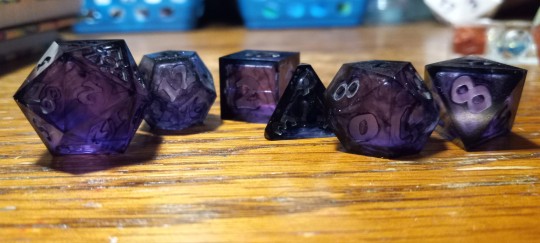
And round, featuring teal sand and gold foil!

(These are both missing a percentile because I had to make a second d10 shell mold for both and I got impatient and wanted to test them first)
Now you may see the d4s and think they look kinda funny. They do, which is why they're off to the printer for round 3 of prototypes sometime this week. It's a bit hard to tell for the darker set, but the shell is still *just* too small so that has been adjusted. Also the tiny orb in the center of the rounded version ends up slightly off center for the same reason, and the orb itself should turn out to be about 50% larger so it's not so.. awkward. The new size should hopefully fit better and also be easier to fill. The current ones are stubborn.
Also, while those are getting reprinted, a new d4 shape (a crystal shard - I've teased it here before) is also being printed, as well as its accompanying shells and blank!
The shells have improved a lot from the first attempt, which ended up oddly textured and kinda blurred on the inside. They were also awkwardly thick in the first run. The following two dice were made in the same mold, with the silver one actually being made first. The outside surface is the same, but the inside is definitely not.
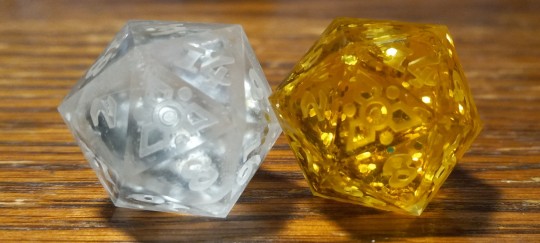
V1 (gold) vs V2 (red) - it looks so much better! I also managed to keep sharper edges in the second round as well

That's a nice notebook
The new shells aren't perfectly smooth on the inside (and definitely not on the outside, but that gets coated in more resin so that texture disappears). The newer ones have the finish that reminds me of how the glass in stained glass tends to look, which is a neat effect.

Since the shells are made of resin, I can make them any color or effect I want! The seams on these are fairly obvious at this stage, but they've been sealed with epoxy resin as opposed to UV resin, which so far has proven to hide the seams better in the end. I'm still practicing that part with the resin, but I made some silicone guides to help make sure they're aligned properly.
I can also insert things like glitters or clay fruit slices in the shells!
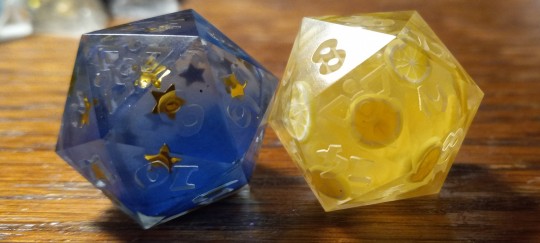
So these are nearing the end of the development stage and I'm tentatively preparing for them to be launched in February, which is wild to me because it would be almost exactly 2 years after I first started making sets, which were nowhere near as nice as they've become now.
So if you've been here from the beginning or if you recently joined to follow along, I'm happy to have you here and I hope to be able to share more progress soon as well as maybe some new projects coming along!
-MJ
#artificer dice#liquid core dice#handmade dice#mjs shop talk#polyhedral dice#long post#undescribed#sorry but there's a lot and I'm not the best at describing things#i have more examples of prototypes i can share in the next few days but the things I'm making take a minimum of 3 days for casting alone#i did a few as commissions but i figured generic versions of the same concept might be better examples than the obscure references#plus the design i did may be cute as pride dice 👀#admittedly i did make a rainbow for the first attempt#so that works
5 notes
·
View notes
Text
How to play Ginko D&D 5e
FOREWORD:
I made a simpler version of this build before, which you can find here. I made this one to try to fit in more of Ginko’s traits and stuff. I just like making characters I love in D&D because it’s like a jigsaw puzzle where you know the picture on the box, but you have to figure out which pieces to use to get there. Anyway. Onto the build.
GOALS:
- See things invisible to others - Attract Mushi and their strange phenomenon - Cure people’s magical diseases and solve their magical problems - Get some Mushishi gear and techniques - Try to keep canon character progression in mind
STATS:
Standard array 8 STR, 12 DEX, 10 CON, 14 INT, 15 WIS, 13 CHA (Roll for stats if you want, but keep multiclassing minimums in mind. We’re going to be multiclassing a bit in this build.)
RACE:
Custom lineage Creature type: Humanoid Size: Medium Speed: 30 ft Ability score increase: +2 to Dex (For multiclassing minimums) Variable trait: Darkvision with a range of 60 feet (The effect of the Tokoyami) Languages: Common and Elvish (See background languages for explanation)
Feat: Eldritch Adept: Learn one Eldritch Invocation option from the warlock class. Choose Eldritch Sight, which gives the ability to cast detect magic at will, without expending a spell slot or material components (A basically permanent way to see things few others see. This is the first version of Ginko’s ability to see Mushi.)
BACKGROUND:
Haunted one Skills: Choose Arcana and Investigation (For the ability to see magic in a way that few others can and investigation for figuring out how mushi affect the world) Languages: Dwarwish and Halfling (Ginko has always traveled a lot, and would need to interact with a lot of people, that is why I choose to give him the languages of the most common races)
Harrowing event: Ginko was found wandering the woods as a child, with no memory of his past and magical darkness in his left eye socket.
Feature:
Heart of Darkness: Those who look into his eyes can see that he has faced unimaginable horror and that he is no stranger to darkness. Though they might fear him, commoners will extend him every courtesy and do their utmost to help him. Unless he has shown himself to be a danger to them, they will even take up arms to fight alongside him, should he find himself facing an enemy alone.
LEVEL 1 Sorcerer 1
Proficiencies: Saving throws: Constitution and Charisma Skills: Choose Insight and Persuasion (Both are good skills to have if you’re a traveling mushishi) Spellcasting focus: Choose a material component pouch instead of a spellcasting focus, it’s both more accurate and makes multiclassing spellcasting classes easier.
Features:
Sorcerous Origin: Choose Wild Magic (for the unpredictable mushi that Ginko attracts, and the problems they cause)
Wild Magic Surge: Once per turn, the DM can have you roll a d20 immediately after Ginko casts a sorcerer spell of 1st level or higher. If you roll a 1, roll on the Wild Magic Surge table to create a magical effect. If that effect is a spell, it can't be affected by Metamagic, and if it normally requires concentration, it doesn't require concentration in this case; the spell lasts for its full duration. (The misfortune that happens if one lets too many mushi gather)
Tides of Chaos: This gives the ability to gain advantage on one attack roll, ability check, or saving throw. Once done so, Ginko must finish a long rest before he can use this feature again. Any time before regaining the use of this feature, the DM can have you roll on the Wild Magic Surge table immediately after Ginko casts a sorcerer spell of 1st level or higher. He then regains the use of this feature. (The awareness of the mushi around him grants Ginko an advantage sometimes? I’m struggling to come up with flavor for this feature.)
Spells: Cantrips: Friends (Ginko putting on the charm, to get someone to buy his wares, like in that one episode) Bladeward (Preparing to block an attack from hitting too hard, useful when you don’t wear armor like Ginko) True Strike (Gaining insight into someone’s defenses) Poison Spray (Exhaling mushi-tobacco smoke aggressively)
1st level: Expeditious Retreat (Sometimes a mushishi one needs to run fast, so get that adrenaline pumping Ginko) Silvery Barbs (Ginko distracting someone from what they’re doing, giving someone else the opportunity to act)
LEVEL 2 Sorcerer 2
Features:
Font of Magic: Ginko has 2 sorcery points, and regains all spent sorcery points when you finish a long rest. One can use sorcery points to gain additional spell slots, or sacrifice spell slots to gain additional sorcery points. One can transform unexpended sorcery points into one spell slot as a bonus action. Any spell slot created with this feature vanishes when you finish a long rest. As a bonus action, one can expend one spell slot and gain a number of sorcery points equal to the slot's level.
Spells: 1st level: False Life (Temporary hit points can be flavored into all sorts of things, maybe this is Ginko strengthening his resolve)
LEVEL 3 Sorcerer 3
Features:
Metamagic: Ginko gains two metamagic options. Choose Subtle Spell (Ginko does stuff without somatic or verbal components mostly, so this is for that) and Quickened Spell (For quickened spells, always useful)
Spells: 2nd level: See Invisibility (Allows Ginko to see invisible stuff, and into the Ethereal Plane! That’s what he does!)
LEVEL 4 Sorcerer 4
Features:
Ability score improvement: Choose a feat instead.
Skilled: Ginko gains proficiency in any combination of three skills or tools. Choose Medicine, Nature and the herbalism kit. (This is Ginko starting to come into his own as a traveling Mushishi)
Spells: Cantrip: Acid Splash (Not that in character, but the least out of character cantrip left, he can throw a vial of acid at someone. I bet he has acids in his mushishi backpack) 2nd level: Enhance Ability (Ginko gives someone sage advice on something and causes them to focus)
LEVEL 5 Ranger 1
Proficiencies: Skills: Choose Survival (Ginko is now used to traveling and being in the wilderness)
Features:
Favored Enemy: Ginko has significant experience studying and tracking mushi. Choose a type of favored enemy: elementals (I consider mushi like elementals, often just neutral forces of nature, but I could see fey or aberrations working for them as well.) Ginko has advantage on Wisdom (Survival) checks to track your favored enemies, as well as on Intelligence checks to recall information about them. Ginko also learns one language that is spoken by his favored enemies, if they speak one at all. (So Primordial, Sylvan or even Deep Speech, if anything.)
Deft Explorer (Optional): This 1st-level feature replaces the Natural Explorer feature. Ginko is an unsurpassed explorer and survivor, both in the wilderness and in dealing with others on your travels. He gains the Canny benefit below, and you gain an additional benefit when you reach 6th level and 10th level in this class.
Canny (1st Level) Choose one of Ginko’s skill proficiencies. His proficiency bonus is doubled for any ability check made using the chosen skill. Choose Nature (Ginko is an expert in nature, especially relating to Mushi) Ginko can also speak, read, and write 2 additional languages of your choice. (Choose Gnomish and Goblin, more languages that Ginko has encountered solving the problems of common folk.)
LEVEL 6 Ranger 2
Features:
Fighting style: Ginko adopt a particular style of fighting as his specialty. (His specialty is not fighting at all) Choose Druidic Warrior. He learns two cantrips from the Druid spell list. They count as ranger spells for him.
Spells: Cantrips: Guidance (A reassuring pat on the back from Ginko) Resistance (Another reassuring pat on the back from Ginko, saving throw flavored)
1st level: Detect poison and disease (What it says on the tin, awesome for a mushishi) Cure wounds (Just a quick healing treatment, like a salve or a bandage)
LEVEL 7 Ranger 3
Features:
Primeval Awareness: Ginko can use an action and expend one ranger spell slot to focus his awareness on the region around you. For 1 minute per level of the spell slot expended, he can sense whether the following types of creatures are present within 1 mile of him (or within up to 6 miles if him are in his favored terrain): aberrations, celestials, dragons, elementals, fey, fiends, and undead. This feature doesn’t reveal the creatures’ location or number.
Ranger conclave: Choose Monster Slayer (Mushi are often likened to monsters, but despite the name of the conclave, many of its features and spells are more for protection or identification of monsters)
Hunter's Sense: Ginko learns to identify the strengths and weaknesses of creatures. As an action, choose one creature Ginko can see within 60 feet. He immediately learns whether the creature has any damage immunities, resistances, or vulnerabilities and what they are. (He relies on the years of studying he has done about the different mushi)
Slayer's Prey: Ginko can designate one creature you can see within 60 feet of him as the target of this feature. The first time each turn that he hits that target with a weapon attack, it takes an extra 1d6 damage from the weapon. (Ginko is a peaceful guy, but if he ever needs to fight, he could probably do it.)
Spells: 1st level: Protection from Evil and Good (Can be used to abjure not only evil or good, but many supernatural creatures like elementals, fey and aberrations)
LEVEL 8 Ranger 4
Features:
Ability score improvement: Choose a feat instead. Skill expert: Ginko gains a skill proficiency in one skill, expertise in one skill and one of his ability scores is increased by one.
Skill proficiency: Athletics (Ginko has now gotten used to traveling for long times and trough treacherous wilderness) Expertise: Medecine (Ginko is good at medicine, especially relating to mushi.) Ability score improvement: Increase WIS by one point.
LEVEL 9 Artificer 1
Proficiencies: Tools: Thieves tools and tinkerers tools (Not in character, but we need this class for stuff)
Features:
Magical tinkering: Ginko can touch one Tiny nonmagical object as an action and give it one small magical property. (The details are in this link, but I don’t feel like putting a wall of text that is not in character for Ginko in this build)
Spells: Cantrips: Spare the Dying (Ginko doing first aid and stabilizing an unconscious person) Magic Stone (Throw stones, uh, this is the only other mildly in character cantrip left)
1st level: Identify (Ginko investigating a magical, possibly mushi affected, object) Sanctuary (Just a good non-combat spell, maybe Ginko just begging the enemies to spare the person affected)
LEVEL 10 Artificer 2
Features:
Infuse Item: Ginko has gained the ability to imbue mundane items with certain magical infusions, turning those objects into magic items. (Or he actually gets most of them from other Mushishi in canon, I think.) He learns four infusions.
Infusions: Sending stones (Uro-san!) Wand of Magic Detection (Reflavor this to be the sake that lets one see mushi) Mind Sharpener (Just a useful item for a person like Ginko with concentration spells) Ersatz eye (Like in Episode 2)
LEVEL 11 Ranger 5
Features:
Extra attack: Ginko can now attack twice, instead of once, whenever he takes the Attack action on his turn. (Did you know, you can use attacks to shove or grapple a creature? This feature just means that Ginko kan grab two mushi in one turn!)
Spells: 2nd level: Lesser Restoration (Ending diseases or conditions, yay! Who knows what kind of healing stuff he has in his backpack) Zone of Truth (Ginko has a calming presence that makes people want to share personal things)
LEVEL 12 Ranger 6
Features:
Favored Enemy improvement: Choose an additional type of creature to be affected by the Favored Enemy feature. (Choose another from the list I set that mushi could be: fey, elementals or aberrations, for more mushi and mushi adjacent knowledge)
Deft explorer improvement: This feature improvement replaces the Natural Explorer Improvement.
Roving (6th Level) Ginko’s walking speed increases by 5, and he gains a climbing speed and a swimming speed equal to his walking speed.
LEVEL 13 Ranger 7
Features:
Supernatural Defense: At 7th level, Ginko gains extra resilience against your prey’s assaults on your mind and body. Whenever the target of the Slayer’s Prey forces Ginko to make a saving throw and whenever he makes an ability check to escape that target's grapple, add 1d6 to the roll. (Knowledge of how to avoid the effects of mushi)
Spells: 3rd level: Locate Animals or Plants (Ginko tapping into the Mugura to find things, like in episode 11)
LEVEL 14 Ranger 8
Features:
Ability score improvement: Increase WIS by two points (for better healing)
Land's Stride: Starting at 8th level, moving through nonmagical difficult terrain costs Ginko no extra movement. He can also pass through nonmagical plants without being slowed by them and without taking damage from them if they have thorns, spines, or a similar hazard. In addition, Ginko has advantage on saving throws against plants that are magically created or manipulated to impede movement, such as those created by the Entangle spell. (Ginko is used to traveling through nature and its impediments, supernatural or mundane)
LEVEL 15 Ranger 9
Spells: 2nd level: Protection from Poison (The best kinda in character spell that was available at this level I could find. If you do the Expanded Ranger Spell List from Tasha’s then do Revivify)
3rd level: Magic Circle (Ginko fills a place with a lot of mushi tobacco smoke to abjure mushi! (Like in episode 3, episode 23 and in season 2 episode 10!))
LEVEL 16 Ranger 10
Features:
Tireless: As an action, Ginko can give himself a number of temporary hit points equal to 1d8 + his Wisdom modifier (minimum of 1 temporary hit point). In addition, whenever Ginko finishes a short rest, your exhaustion level, if any, is decreased by 1. (Ginko has to be tireless to travel all about like he does.)
Hide in Plain Sight: Ginko can spend 1 minute creating camouflage for himself. He must have access to fresh mud, dirt, plants, soot, and other naturally occurring materials with which to create his camouflage. Once he is camouflaged in this way, he can try to hide by pressing himself up against a solid surface, such as a tree or wall, that is at least as tall and wide as he is. He gains a +10 bonus to Dexterity (Stealth) checks as long as he remains there without moving or taking actions. Once he moves or takes an action or a reaction, he must camouflage himself again to gain this benefit. (This is not something he does, but something he totally could do.)
LEVEL 17 Ranger 11
Feature:
Magic-User's Nemesis: Ginko gains the ability to thwart some magic. When he sees a creature casting a spell or teleporting within 60 feet, he can use his reaction to try to magically foil it. The creature must succeed on a Wisdom saving throw against your spell save DC, or its spell or teleport fails and is wasted. (Ginko knows many ways to neutralize effects of mushi ‘magic’, this is him quickly reacting to it with some kind of neutralizing component in his backpack)
Spells: 3rd level: Plant growth (Ginko putting kouki on the ground, not something he would do carelessly)
LEVEL 18 Ranger 12
Features:
Ability score improvement: Increase INT by two points (for better recollection of mushi facts)
LEVEL 19 Ranger 13
Spells: 4th level: Locate Creature (Ginko tapping into the Mugura to find things, like in episode 11) Banishment (Ginko is good at chasing away mushi, probably with some kind of think in his backpack, depending on what type it is)
LEVEL 20 Sorcerer 5
Features:
Magical Guidance: When making an ability check that fails, Ginko can spend 1 sorcery point to reroll the d20, and must use the new roll, potentially turning the failure into a success.
Spells: 3rd level: Dispel Magic (Ginko dispersing the kind of mushi causing a magical effect)
AFTERWORD:
Right. I would have loved to have gotten Scrying instead of the Locate Creature spell, since that seems more accurate with how Ginko used the Mugura, but I couldn’t find a way to get it to work. I also tried to get to features that could re-roll the d20 before the Wild Magic Surge, but ruels as written, I can’t since it’s not a attack roll, ability check or saving throw, and all reroll features specify it has to be one of those things. Thought it would be cool to have him control the effects of the random mushi that are attracted to him by making them not happen, as the build grew but no. So this is it. Hope you enjoyed.
4 notes
·
View notes
Text
Dwelling on this I don’t even mean “it’s like a completely different RPG.”
Like they’re both monotheistic religions, they both have similar roots, one of them originates from the other so they kinda branched of sorts, and some other stuff that I’m probably gonna stop at here before I get too Heretical.
And like.
To someone who doesn’t know any better like myself, the vibes are kinda similar, and you can say that about the rules between systems as well.
But they’re also so fundamentally different that they just are hard yet easy to compare.
Like they’re both D20 systems, they both are combat heavy, they both focus on attrition, but while D&D has a pretty rigid structure for making characters (in 5E, though I’d argue earlier editions are somewhat rigid too with multiclassing and feats), Lancer gives you so much freedom, options, ability to cross dip, and flexibility that it’s almost overwhelming. Also it has a lot more structure for out of combat thanks to a heavy Blades in the Dark influence and a more rigidly defined combat that feels clear cut and therefore easier and more fun to engage with.
Also one is a Fantasy Game about being ragtag adventurers with way too much power and the other is a game about piloting a fucking mech in a struggling to exist and spread its bounty Utopia.
What Non DnD TTRPGs Feel Like
Okay, quick thread about what playing different non DnD ttrpgs feels like.
--
Pathfinder
This is DnD. It feels like DnD. It's like going to a slightly different church. Some of the words used during the service are different, but at the end of it the pulpit turns out to be a mimic and you cast Entangle and summon your direwolf.
--
Fate
This is Rule Of Cool with additional rules. The GM has powers to one-up you or lead you into temptation, but you have powers to one-up the GM, and all these powers use the same kind of token that you ultimately shuffle back and forth.
--
Savage Worlds
Handwave-style DnD (positive connotation.)
The GM has a lot of freedom to pick genre and setting, and the gameplay is sleeker, rule-of-cool-ier without losing meaningful combat or character building.
--
Call Of Cthulhu
You may not be an old librarian, but you sure are built like one. Most acts of violence can flatten you in a couple of hits, but violence doesn't happen often. It's the punctuation mark at the end of a long sentence. Atmosphere and pacing rule over this land.
--
World Of Darkness
This is a game about getting deep into your character's headspace. It's about figuring out who they are and roleplaying them passionately. Your backstory choices and powers have a huge affect on how you interact with the world around you.
--
Warhammer Fantasy / Dark Heresy
You are Scrumbles McGrumbles, a walking heap of morbidity and washed-up soldiering. You are trying to find your place in a world that's having an even worse day than you are. Your best friend is a ratcatcher. Together you will be heroes.
--
OSR (Mork Borg, Mausritter, Into The Odd, Dungeon Crawl Classics, Labyrinth Lord, Cairn, tons more)
DnD boiled down to two components: GMing + Making A Guy. GMing is made as easy as possible and PCs are somewhat disposable, so the story is the hijinks you get into together.
--
Powered By The Apocalypse (Masks, Nahual, Monsterhearts, Pasion De Las Pasiones, tons more)
The goal is to get into trouble and stir up drama. Succeeding on a roll with no consequences is rare, but when you fail you fail forward into even bigger, messier drama.
--
Blades In The Dark
You go on missions and then return to your base. The missions are about choices as much as about rolls, and you build your base together to make yourselves more powerful as a squad.
--
Trophy
Your goal is to lose. Specifically, it's to lose in a dramatic and harrowing fashion that sticks with everyone at the table. Think movies like Annihilation, but as oneshot games.
--
Golden Sky Stories
You like everyone at the table with you. When someone does something adorable, you can award them exp. The highlight of the session is someone getting flustered and/or speaking in a squeaky voice.
--
Ryuutama
You are going on a journey and helping other people along the way. Important choices include packing lunch, wearing appropriate clothing, and completely filling your canteen. Combat is a cozy, pastel color jrpg.
--
The Indie
There are so, so many games that are just completely their own thing, and that I can't squeeze into a single thread. If you discover you like game mechanics and you want to Get Weird with seeing what they can do, there is an entire scene here waiting to welcome you.
--
Stuff I Missed
There's lots of stuff I haven't played, or didn't remember in the moment, or absolutely love but it would take a whole thread to explain why I love it. I will do more game recommendations in the future, but you can also comment systems you like below!
6K notes
·
View notes
Text
Starfall: Frontiers - Core Concepts
Hello and welcome to the first in a line of posts detailing the mechanics of Starfall. A Familiar Foundation
Starfall uses the almighty D20 and, in general, it uses all the standard "RPG Dice". I also added in the D3 but this isn't really a new dice since you can just roll it on a D6.
I used to be a Game Master for a lot of Dark Heresy and Deathwatch games and if you are familiar with those, or really any Fantsy Flight TTRPG system, you will know that it uses D10s as its main dice type with weird dice like the D5 thrown in there. Its a good system, don't get me wrong, but I personally think the familiarity of a D20 system is nicer.
Attributes
Much Like Other TTRPGs, Starfall uses the standard 6 abilities (though I named them attributes): Strength, Dexterity, Constitution, Intelligence, Wisdom, Charisma.
Again, this is a situation of wanting to make Starfall familiar and friendly to those moving over from other systems. The real deviation from the norm comes from how Starfall uses these Attributes.
Effort, Ace and Exertion
Numenera is a frankly incredible TTRPG, if you haven't played it, please do, its amazing. The main crux of that game is the concept of Effort. Every task is difficult and you and expend some effort from one of three pools to make it easier. Effort is a resource that refills once per day.
In Starfall, I wanted something similar, so I created the concept of an Effort Test. Each task is given a fixed Difficulty Class from 1 to 10 by the GM. This is how generally difficult the task is. It's rolled on a D20 and instead of the DC being the value you need to reach, each DC specifies a minimum value required on the D20 to pass the Test.
Players can spend Effort from one of their Attributes to lower the DC of the task. They can spend a number of Effort up to their Exertion. This means that a low level character can't put as much Effort into a task as a high level character can.
In addition to Effort, players also have Ace. Ace is a separate Attribute that scales as your character progresses and usually, characters will be an Ace with two Attributes. When a character makes an Effort Test that uses one of those Attributes, they automatically reduce the DC of that Effort Test by their Ace. This reduction also doesn't count towards their Exertion.
Effort Tests are how everything is done in Starfall, from making attacks, to mocking diplomats. While there are other concepts like Advantage and Disadvantage, Resolve, Attribute Bonuses and more, I will cover all of those in future posts (hopefully one post a week if I can remember to do it). Starfall: Frontiers has a discord server, you can join it here: https://discord.gg/eUSJ8zxVnf
0 notes